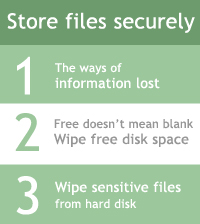Wipe
file and clear disk space
 Today
million people are working in offices on million computers. Now itís no
wonder, as a few years ago, having PC at home. You can play the games, read
articles, listen to the music, browse Internet pages. And all of these are
only files. Today
million people are working in offices on million computers. Now itís no
wonder, as a few years ago, having PC at home. You can play the games, read
articles, listen to the music, browse Internet pages. And all of these are
only files.
Download
evaluation version of QuickWiper from www.quickwiper.com
Simple
look at file system
All
kinds of information is stored in computers as a files. Each file takes some
place on a hard disk. And the first (and main for our issue) problem is you
never know where itís placed, and how much disk space it occupy.
Operating
system acts with this in itís own way. To save file on a hard disk it
takes any free space.
It
is to note hard disk is divided for logical parts of definite sizes.
Smallest of it is named cluster. So, OS is taking as many number of clusters
or sectors allocated to file as needed to it. The area of disk space
provided, is always larger than the file itself. Also it may occur file will
be parted and placed in various clusters. Deleting a file alone, leaves a
space which can contain sensitive data. There are a number of ways in which
this sensitive data can be deposited without a user knowing it.

Also,
every time a file is updated or "saved", new copies are created
and written wherever there is sufficient space. Applications can create huge
numbers of such files. When a file is eventually deleted, only the last
image is accounted for. All other images appearing as free disk space,
unseen, unsuspected. That's why undelete programs are possible.
Letís
try to wipe file
Well,
letís imagine you need to delete some file. You press ĎDelí (or
ĎShift&Delí to erase file without Recycle Bin going in). OK, your
file is disappearing from hard disk!
However,
a this traditional method for deleting a file from permanent storage space
is just to delete the pointer contained in the file directory that points to
the information blocks comprising the file. The actual contents of the
information is left untouched. Using a utility program, the contents of
every block of storage space can be scanned for sensitive information.
More
particularly, although storage space is freed up for other uses, the file's
data content is left untouched until the storage space is actually used for
another file storage. This is inherently dangerous because the user believes
the data is gone, yet a skilled intruder can use powerful utility tools to
scan for these deleted files.
Use
special wiping utility to really clear disk space
Another
conventional method of file deletion requires a user to overwrite 0's and
1's over the entire data file as to remove any magnetic remnants of the
removed information. As user canít do it by yourself it would do special
program, for example such as QuickWiper.
The
erasure is performed by using the encryption algorithm so that the contents
of the file cannot be retrieved by other users after the erasure. When the
secure wiping method is used, no utility program can recover any information
from the deleted file. To an intruder, the storage space is encrypted to
look like random bits. Therefore, no information can be retrieved nor
derived from the encrypted, deleted file.
Well, whatís the result? Using wiping program we
may be calm for high level of safety of securely deleted data. No one, even
yourself, can recover sensitive information. It would be a great trouble to
do it by any recovery utility, no doubt, no variants. However, if you are a
little paranoid, read article below.
Related
articles:
-
Points
on information storage and security. At
present IT-corporations invests millions of dollar in development of
information security techniques. But the only problem is researching how
to make public information accessible to all users, and confidential
data accessible only to whom
itís intended.
-
Short
review on non-software methods of destruction of the information on
hard drives. Sometimes,
when the highest reliability is needed, itís using mechanical and
other methods of destruction of the information, when HDD is breaking as
oneself.
-
Wipe
file and clear disk space. All
kinds of information is stored in computers as a files. Each file takes
some place on a hard disk. And the first (and main for our issue)
problem is you never know where itís placed, and how much disk space
it occupy.
-
Disk
space: free doesnít mean blank. Letís
repeat, when you delete sensitive files from a disk on your computer,
Windows does not erase the contents of these files from the disk - it
only deletes 'references' to these files from file system tables.
Contents of the deleted file continue to be stored on the disk space and
can be easily recovered using any unerasing utility.
|